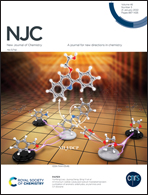Electrochromic behavior of fac-tricarbonyl rhenium complexes†
Abstract
This paper aims to investigate the electrochromic properties of tricarbonyl rhenium complexes. Using 4,7-diphenylphenanthroline (L1) and 4,7-di(4-substituted)-1,10-phenanthroline (L2–L5) as bidentate ligands, a series of tricarbonyl rhenium complexes, fac-Re(CO)3(Lx)Cl (x = 1–5), were synthesized and characterized by infrared spectroscopy, 1H NMR, 13C NMR, and high resolution mass spectrometry. Their stereochemistry was investigated by single crystal X-ray diffraction. Theoretical highest occupied molecular orbital and lowest unoccupied molecular orbital charge distributions of fac-Re(CO)3(Lx)Cl were calculated by density functional theory calculations. Their electrochemical and electrochromic properties were studied by cyclic voltammetry, UV-vis spectroscopy and chronoamperometry. All fac-Re(CO)3(Lx)Cl complexes underwent a quasi-reversible reduction–oxidation process and an anodic peak at 1.3 V vs. Ag/Ag+. Electrochromic devices based on fac-Re(CO)3(Lx)Cl exhibited good electrochromic performance such as an obvious change in color from bleached yellow state to colored green state (a challenging electrochromic color), rapid response time of less than 3 s, moderate optical contrast and coloration efficiency, and good switching stability (fac-Re(CO)3(L2)Cl retained 95.2% of its initial optical contrast after 2400 electrochromic switching cycles). The fac-Re(CO)3(L2)Cl with an electron-donating group (–OCH3) at its para-position exhibited better performance including good switching stability, a higher optical contrast and a significant change in color than the unsubstituted, –CH3 substituted, –COOCH3 substituted and Br-substituted analogues.



 Please wait while we load your content...
Please wait while we load your content...